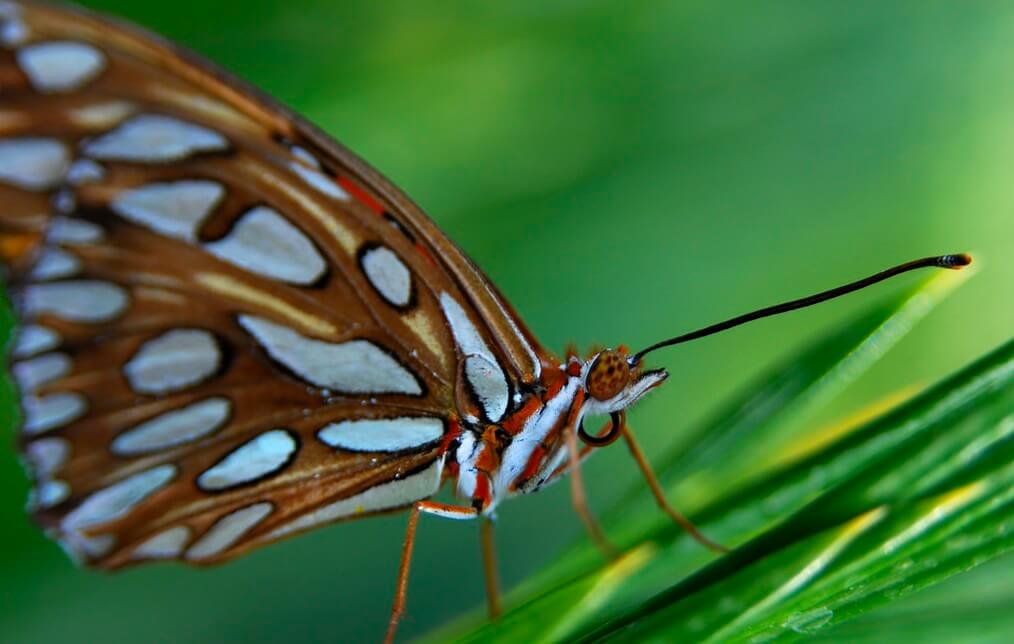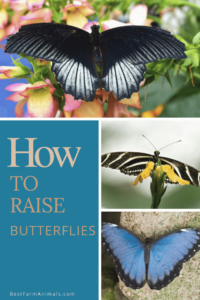One of my daughters earliest memories is watching a butterfly chrysalis turn into a butterfly. She got to hold it on her finger before releasing it outside. Raising butterflies offers great benefits to small animals. It creates awareness, fosters a love of nature in children, and helps to raise the population of endangered species. Let’s discuss How to raise a butterfly.
15 Steps To Raising Butterflies
Butterflies have several needs including the needs of the caterpillar, the needs of the chrysalis, and the needs of the butterfly. If you are going to raise butterflies, it is important to understand those needs and provide for them or your butterflies will perish. Butterflies have only a 10% chance of surviving in the wild so by helping to raise butterflies, you can participate in helping these delicate creatures.
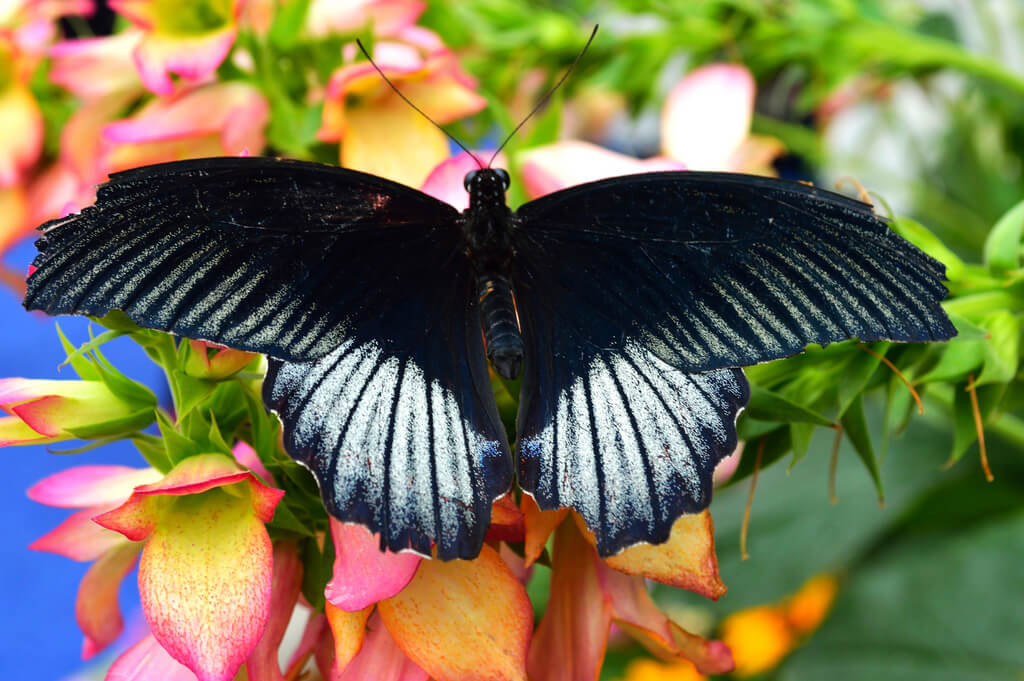
1. Identify The Types Of Butterflies Native To Your Area
Butterflies across the world are declining in population. But just because a butterfly is endangered doesn’t mean that it can be released anywhere.
Why Is It Important To Raise Native Butterflies?
Raising and releasing butterflies into an area that they aren’t native to can harm and damage other native species. This could result in the decline of butterflies necessary to your ecosystem. Butterflies play an important role in ecology.
Furthermore, it can doom the non-native butterflies to death. If they don’t have other butterflies to mate with, then attempting to “help” them can result in death without reproduction. This can keep those same caterpillars from growing in their native habitats and helping those butterfly varieties.
It is best to encourage the growth and population of butterflies native to your area. There are over 20 species of butterflies that are listed as endangered by the US Fish and Wildlife Service. There are more species across Europe and Asia that are quickly vanishing.
Click here for a guide to what species are native to different regions across the United States.
How Do Non-Native Butterflies Hurt Native Butterflies?
Butterflies have a host of predators. Because of this, they are colored in different patterns and colors. Introducing a non-native butterfly population to a new location can attract non-native predators to the area.
This introduces new predators of native species and can play a big part in the destruction of native species. Additionally, non-native butterflies may have similar appetites to those of native butterflies. They may compete for already dwindling food supplies and cause the decline of native species through starvation.
This can also cause native butterflies to struggle to find the right types of plants for the caterpillars to hide or build the chrysalis’ on. This makes native species more susceptible to predators.
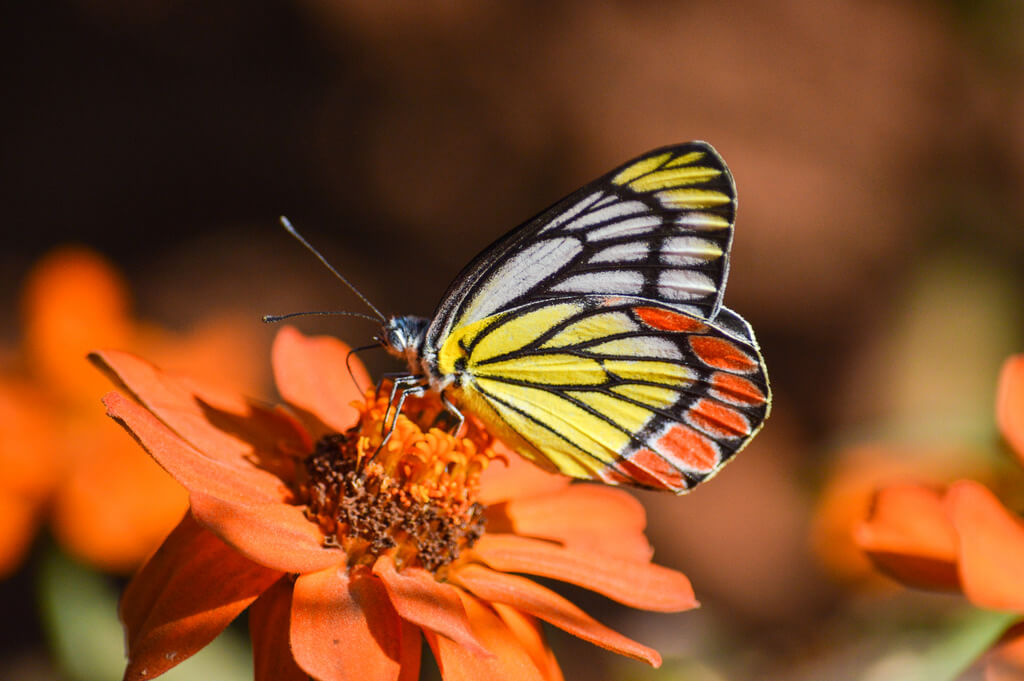
2. Identify What Type Of Butterfly You Will Raise
Raising butterflies starts with raising the correct types of caterpillars. If you haven’t raised butterflies before, then you will need to learn how to identify the right types of caterpillars and where they grow. This can feel discouraging if are just starting to learn.
Instead, you can purchase caterpillars of species native to your area and raise them into butterflies. The caterpillars are shipped to you with all a butterfly growth medium, the necessary food and the container needed for their good health. This allows you to learn and understand more about caterpillars.
Then, as you spend time outside in your city or nature, you will naturally start to identify when you see the same type of caterpillar. You can choose to raise endangered caterpillars or to raise more common butterflies.
Benefits of Raising An Endangered Species of Butterfly.
If you choose to raise an endangered species of butterfly, you can help to increase the population of endangered species. The more people who get involved, the more likely the species is to survive and eventually thrive again.
Human intervention has already saved many species of animals from total extinction, some of which were caused by human changes to natural habitats.
What Are The Benefits Of Raising A Non-Endangered Butterfly?
All types of butterflies help the ecosystem. Butterflies don’t prey on other butterflies. It won’t hurt other endangered butterflies in your area. Plus nearly all species of butterflies are declining in population. They all need our help.
Choosing to raise a less-endangered species of butterfly still helps.
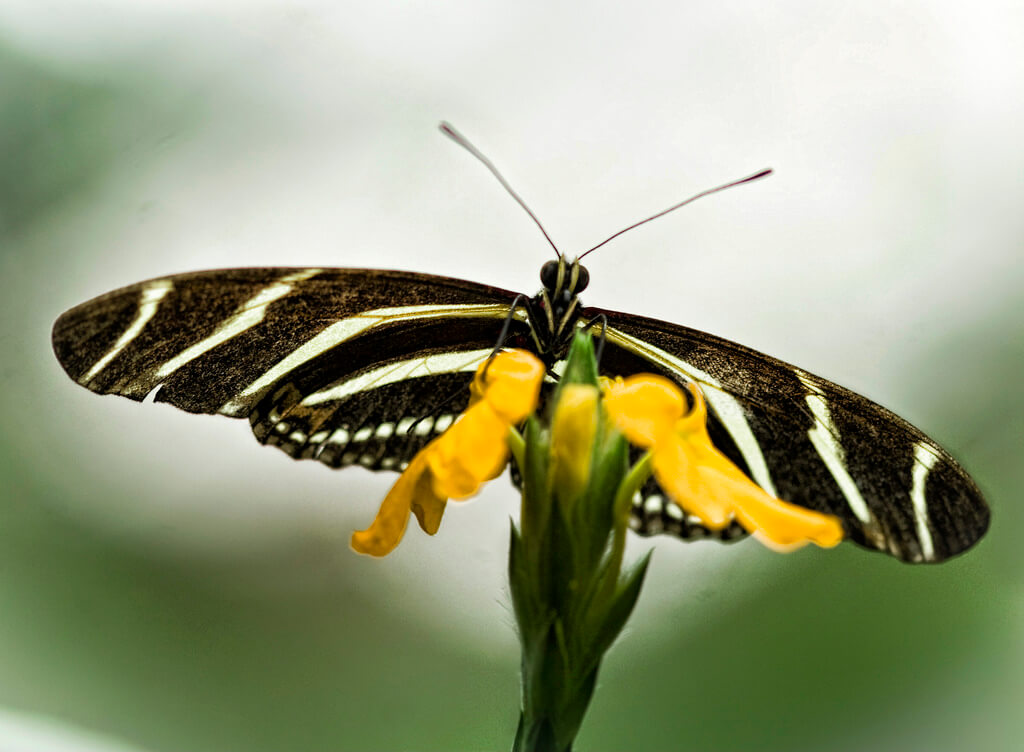
3. Understand The Needs Of A Butterfly Caterpillar
Butterfly caterpillars need several things. They need the right type of food. They need water. They need protection from predators. They need the right environment.
Food: Caterpillars eat plants. They much almost exclusively on leaves, although some caterpillars may also eat the seeds of some plants. Caterpillars eat a lot of food. This is needed to help them grow fat and to have the energy to create a healthy chrysalis.
Water: Caterpillars need water. When raising caterpillars, you can provide the water by spraying the leaves of the caterpillar’s food with a fine mist from a water bottle. You can also provide the water by washing the food.
Protection: Caterpillars are very susceptible to getting eaten. Lots of animals eat caterpillars. Birds of all types love too much on butterfly caterpillars. (This includes chickens.) Female beetles love to eat caterpillars. Yellow jackets are also predators of caterpillars.
Raising your butterflies in a protected place raises their odds of survival from 10% to over 80% during the caterpillar and chrysalis stages.
4. Identify And Collect Caterpillar Food
Caterpillars eat a lot of food! A single monarch caterpillar can eat an entire gallon of milkweed in two weeks! That’s similar to a newborn baby eating 1300 pounds of baby food in its first 2 weeks of life.
They must eat a lot because creating a chrysalis and turning into a butterfly takes a lot of energy. Caterpillars that don’t get enough food to eat will be smaller and less likely to emerge as butterflies. When that happens, the chrysalis dries up and dies.
What Kinds Of Food Do Butterfly Caterpillars Eat?
Every type of caterpillar prefers their own types of food. Offering them the wrong plants will result in the starvation of your caterpillar. Some caterpillars, such as those of the Painted Lady Butterfly, can be fed caterpillar food. That’s a substitute for it’s preferred plant and will keep it alive.
What Butterfly Caterpillars Eat:
| Type of Butterfly Caterpillars | Plant Food | Type of Butterfly Caterpillars | Plant Food |
| American Copper | Sheep Sorrel | Northern Cloudywing | Clover |
| Black Swallowtail | Fennel, Drill, Carrots, Parsley, Parsnips | Orange-Barred Sulphur | Pea plants, Alfalfa |
| California Sister | Live Oak | Orange-Bordered Blue | Legumes |
| Cloudless Sulphur | Wild Senna | Painted Lady | Thistle |
| Common Blue | Dogweed Flower | Pipevine Swallowtail | Pipevine |
| Common Buckeye | Snapdragon | Question Mark | Elm |
| Eastern Tailed Blue | Legumes | Tiger Swallowtail | Tulip Tree |
| Fawn | Birch | Sara Orange Tip | Wild Mustard |
| Filed Crescent | Aster | Silver Spotted Skipper | Wisteria |
| Greater and Lesser Fritillaries | Violet | Southern Cloudywing | Clover |
| Great Southern White | Mustard | Southern Dogface | Mustard |
| Grizzled Skipper | Mallows | Spicebush Swallowtail | Sassafras,
Spicebush |
| Gulf Fritillary | Passion Flower leaf | West Coast Lady | Mallows |
| Julia | Passion Flower leaf | Zebra Swallowtail | Paw-Paw |
| Mourning Cloak | Elm, Willow, Poplar | Zebras | Passion Flower leaf |
| Monarch | Milkweed | Zephyr | Elm |
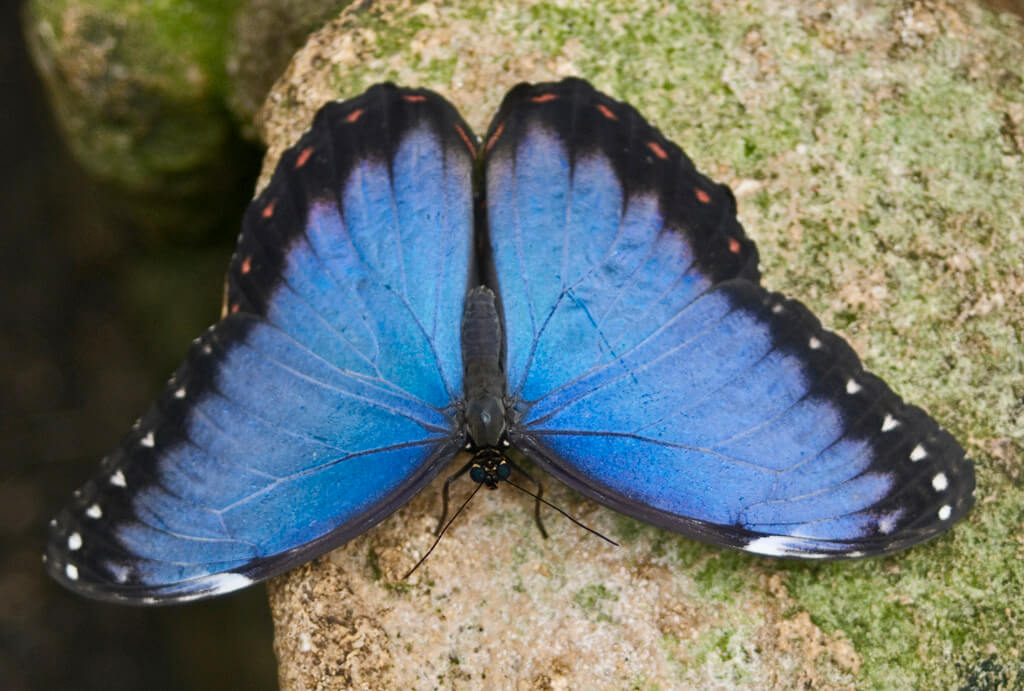
5. Create A Safe Caterpillar House
A caterpillar house needs a clean environment, plenty of fresh food, a safe place, and a way to climb.
You can create a safe place for your caterpillars by using a 1-gallon jar or a small aquarium. I got my first 1 gallon jars from a local sandwich shop, which uses bottled banana peppers and throws away the jars.
If you have a small aquarium or another sealable container, that will also work. If you are using a lizard aquarium or other types of containers with small holes, you will need to modify them so your caterpillar doesn’t escape.
Add about 2 inches of soil to the bottom of your jar. Some types of caterpillars will pupate (poop) above ground. If you are raising caterpillars that do that, you can line the bottom of your cage with a paper towel. Otherwise, add soil the first time you raise a butterfly.
Use a cheesecloth to cover the openings in the jar or aquarium. This will allow the air to breathe while also keeping your caterpillar safe. If you use a jar with a lid, make sure that you open it and wipe off the excess moisture in the jar.
Your caterpillar will need food and sticks inside it’s home. It needs a place to hang its chrysalis. Caterpillars will hand them off of sticks. If you have a hard lid on your caterpillar cage, it may also hang from the lid of the container.
If this happens, be very careful when opening your lid. The smallest vibrations can dislocate a chrysalis from it’s hanging location. The chrysalis is the most fragile part of a butterfly’s life.
Choose a location that is safe for your caterpillar. It should be in a place that isn’t cold
6. Collect Caterpillars
You can collect caterpillars from nature or purchase them online. Even if you live in a city, caterpillars can often be found outside on host plants. Check lawns, flowers, and weeds for caterpillars.
Another great place to check is in alleyways. These are often places where host plants aren’t trimmed or mowed down. This gives butterflies a chance to lay their eggs and for caterpillars to emerge.
When collecting caterpillars, check the underside of leaves. One of the ways that caterpillars try to protect themselves is to hide on underneath leaves. This protects them from birds and other predators.
If you choose to purchase your caterpillars, make sure that you purchase a caterpillar that is native to your area.
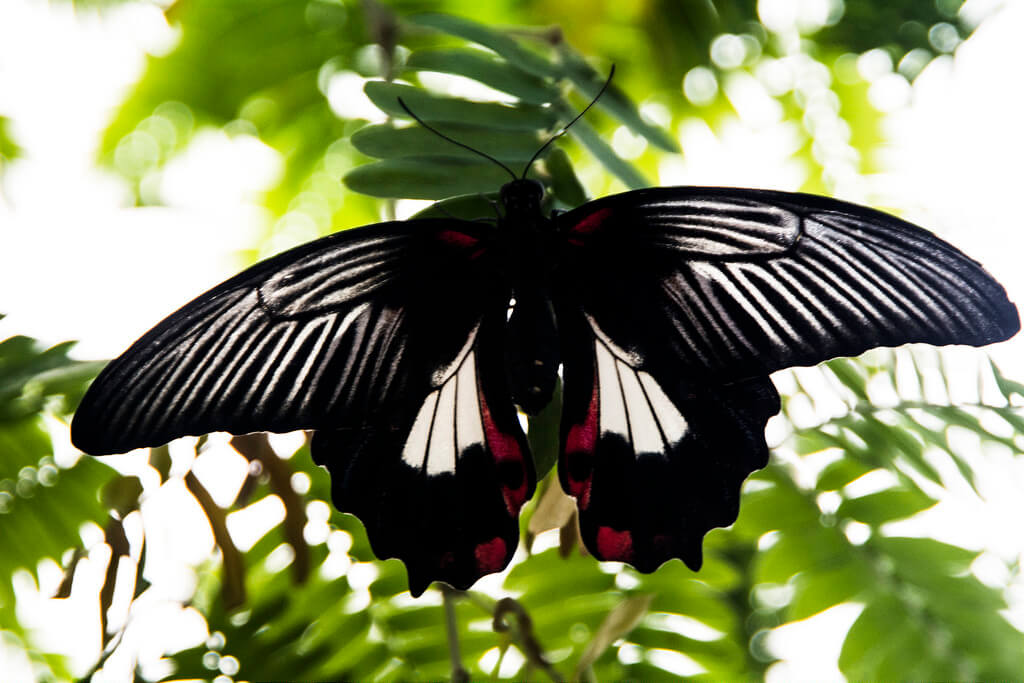
7. Keep Your Caterpillar Healthy And Strong
Caterpillars are extremely subject to bacteria and infections. Germs that don’t hurt people can kill a caterpillar. Additionally, they fight pesticides on plants and other poisons. There are several things that you can do to keep your caterpillars healthy and strong.
- Wash your hands before handling caterpillars. Even if your hands look clean, they can contain bacteria dangerous to your caterpillars.
- Wash the Caterpillar’s plants that you bring in to feed your caterpillars. Inspect the plants and make sure that they don’t have additional caterpillar eggs underneath them. The eggs will look like small round balls and will be very small. They may even look like specs of white dust.
If you find leaves with possible eggs on them, put those leaves into a different container than your live caterpillars. This will help to keep your caterpillars safe if your unwashed leaves have pesticides on them. It will also help with your caterpillars’ health if the eggs are for other species of insects.
- Provide Fresh Food Daily to your caterpillars. Caterpillars have large appetites, but they won’t eat dried up or old host plants. They want fresh leaves to eat. If the leaves aren’t fresh, then caterpillars won’t get enough water from the plants to be healthy.
- Wipe off excess moisture from the cage. Caterpillars won’t be healthy in a moldy environment and excess moisture encourages mold to grow.
- Don’t leave standing water in your cage. Caterpillars can drown in standing water. For that reason, it is best to keep your fresh plant cuttings in floral tubes. This keeps the plants fresh longer and doesn’t endanger your caterpillars.
- Clean out caterpillar poops daily and wipe the cage clean with a damp cloth. If any leaves or other things start to mold, remove it from the cage immediately.
- Don’t mix caterpillars of different sizes. Once you have caterpillars growing, don’t add new baby eggs and caterpillars. That could cause your little caterpillars to be accidentally consumed by larger larvae munching on the leaves.
8. Protect The Chrysalis From Harm And Danger
Caterpillars are very fragile. They can be easily squashed, eaten, hurt, or infected with bacteria. It is important to understand how to protect your caterpillars from harm.
Handle your caterpillars carefully. Caterpillars are very fragile and can be injured even if they are dropped a very small distance. Make sure to handle your caterpillars without squishing or pinching them. Let them crawl on you and don’t force them anywhere.
Don’t pull caterpillars. Caterpillars grip the surface of things very tightly. If you pull a caterpillar up from a leaf, off your fingers, or from another surface, you can injure it. It is very easy to rip the caterpillar’s prolegs off because they grip things so hard with their prolegs.
Protect your caterpillars from pets. Keep your cages high enough that pets won’t knock the cages down or bump them around. Cats have been known to eat caterpillars. Dogs are often curiously enthusiastic. Both situations can kill a sensitive caterpillar.
Show children how to handle caterpillars safely. If you have children, show them how to safely handle caterpillars and how to be gentle with them. Show them how to hold a leaf or stick in front of the caterpillar and allow it to crawl onto it before moving them.
Do not shake the container. It is especially important once the caterpillar has formed into a chrysalis. Movements of the cage can cause the chrysalis to break and harm the caterpillars
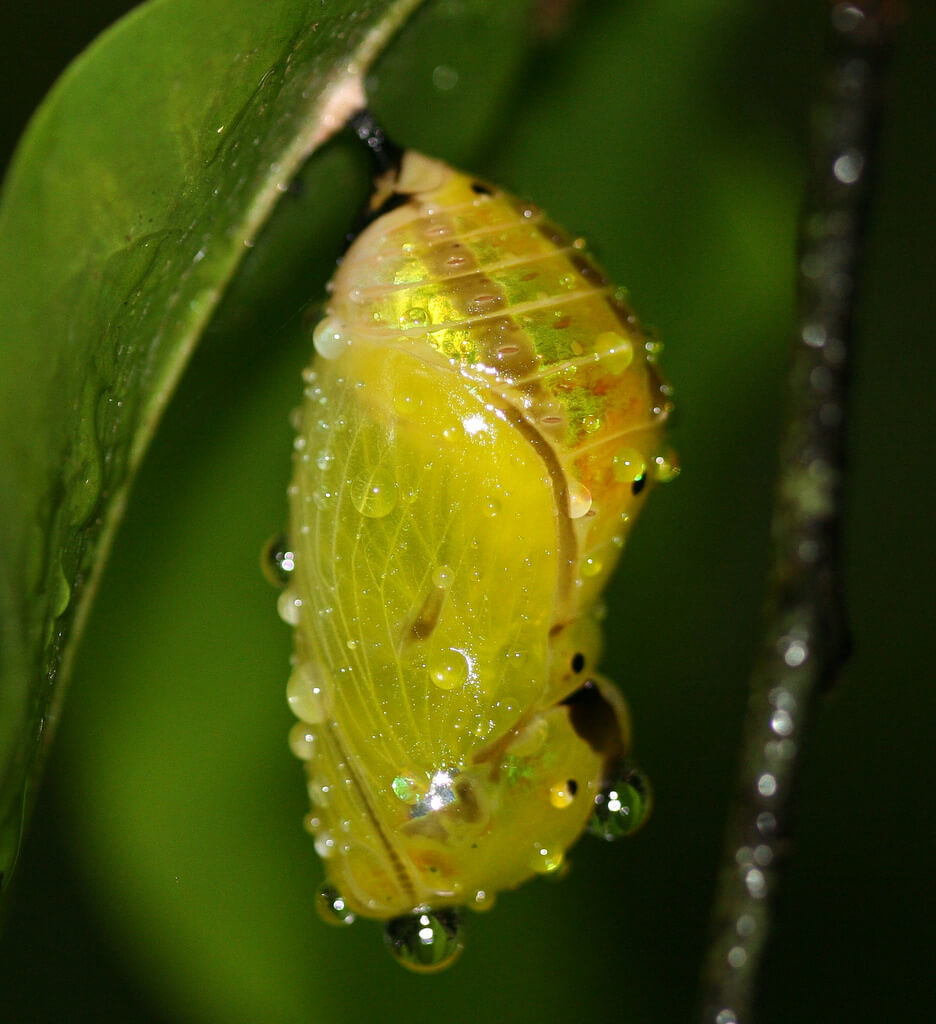
9. Care For The Chrysalis or Pupa
The chrysalis stage is the most fragile stage of a butterflies life. It is also called a pupa.
It is the most vulnerable stage for predators and harm. If you are raising butterflies over the winter, your caterpillar will stay in the pupa stage all winter long. Therefore, you will need to protect the chrysalis all winter long.
Keep the cage slightly humid. If the cage looks too dry, spray a fine mist over and cover it. You should also keep the cage in a spot that isn’t too warm. The warmer the pupa, the higher the metabolism of the butterfly.
Make sure to give your future butterfly enough space to hang and dry its wings when it emerges. If the chrysalis was formed barely above the ground of your cage, you will need to move it.
Gently move the stick higher so that when the butterfly emerges, it can hang its wings.
10. Watch your Butterfly Emerge
It only takes a butterfly a few seconds to emerge from the chrysalis. It happens very quickly. However, you will have warning signs.
Butterfly pupa will either turn a dark color or a clear color just before they emerge. This can happen up to a few days prior to their emerging from the chrysalis. Often when you see the chrysalis turn a dark color, it is actually turning clear and allowing you to start seeing the colors in the butterfly’s wings.
Very dark pupa can mean a dead butterfly.
It is very important to make sure that your cage is humid when the butterfly is getting ready to emerge. Butterflies need water to be healthy. Spray your cage when you notice the chrysalis turning color.
Keep a careful eye on your butterfly because they do emerge quickly. I have spent many hours waiting for a butterfly to emerge only to be distracted for a few seconds and then miss the whole event!
10. Let Your Butterflies Wings Dry
A butterfly needs to dry its wings and let them hang dry to be healthy. If the wings can’t hang, they will be folded and the butterfly will not be able to fly.
So, you should also make sure that all sticks and plants touch the bottom of the cage. That way if a butterfly falls down while its wings are wet, it can still crawl high enough to hang its wings.
Butterflies can take up to a few hours to dry their wings. You may see a yellowish or reddish fluid that drops from the butterflies. This is the extra coloring from the wings. It does not indicate sickness in your butterfly.
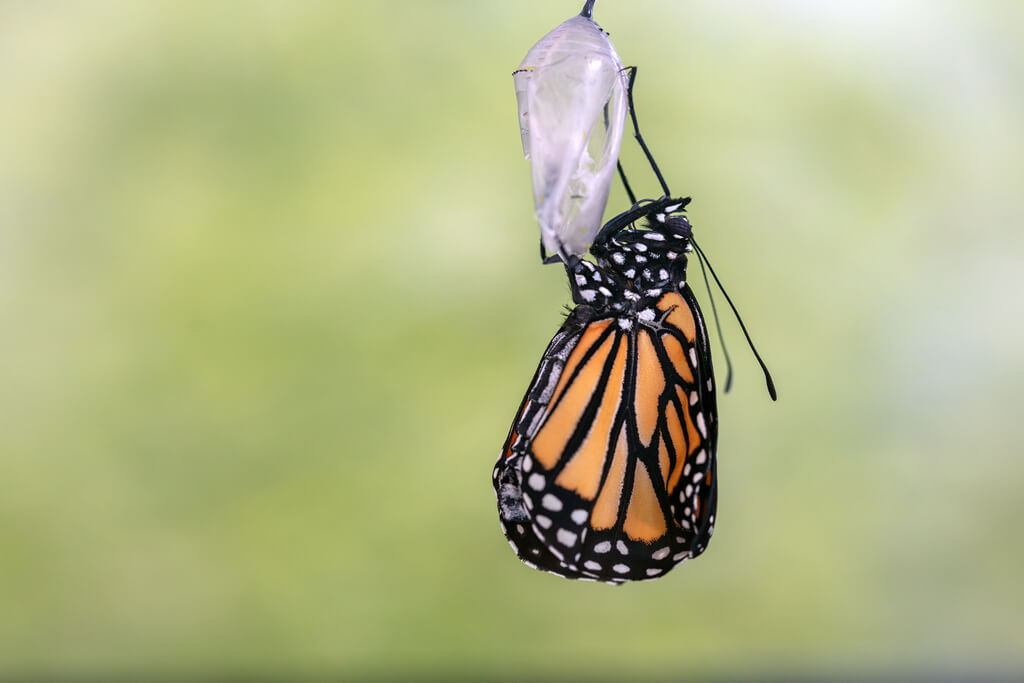
11. Handle Your Butterfly With Care
Butterflies are very fragile creatures. You can hold a newly hatched butterfly once the wings are dry. New butterflies will be calm and less likely to fly away when they are within a few days of hatching. The day they hatch, after the wings are dry, is the best day to hold your butterfly.
Make sure not to squeeze your butterfly.
Also, make sure that you don’t touch the butterflies wings roughly. They have a special powder on them that helps the butterfly to fly. Butterfly wings can be ripped or folded.
This is a way that butterflies can more easily escape predators. When butterflies are caught, the ability to escape through a ripped wing can save their life!
But, all of these things can affect how well butterflies fly and make them more susceptible to predators.
The best way to handle a butterfly is using a scissor grip. (Like holding a cigarette). Gently use two fingers to fold over the butterflies wings. This will keep it from flying away.
You can also gently pinch the tips of your butterflies wings to keep it from flying away until you can get it outside to let it go.
12. Move your butterfly into a safe place
If you choose to keep your butterfly a few days after hatching, you will need to provide a bigger place than the aquarium or jar for your butterfly to fly. Butterflies will need a place to fly that is safe.
You can order a butterfly cage to put your butterfly in so you can watch it for a few days. Butterfly cages need to have a mesh covering with a frame so that your butterflies won’t get caught in it.
I have seen laundry mesh bags used as the covering for a butterfly cage before.
Hang butterfly cages outside where your butterfly can enjoy the sun in safety. Make sure to give it water to drink and plenty of butterfly food.
Butterfly food is usually different than the plants that caterpillars eat. It is usually the nectar from flowers.
You can make butterfly nectar with sugar water that will feed your butterflies for a few days. You can also provide orange slices and carnations to feed your butterflies. Butterflies eat through their proboscis, which sucks up liquid like a straw.
However, you should plan to release your butterfly into the wild after a couple of days.
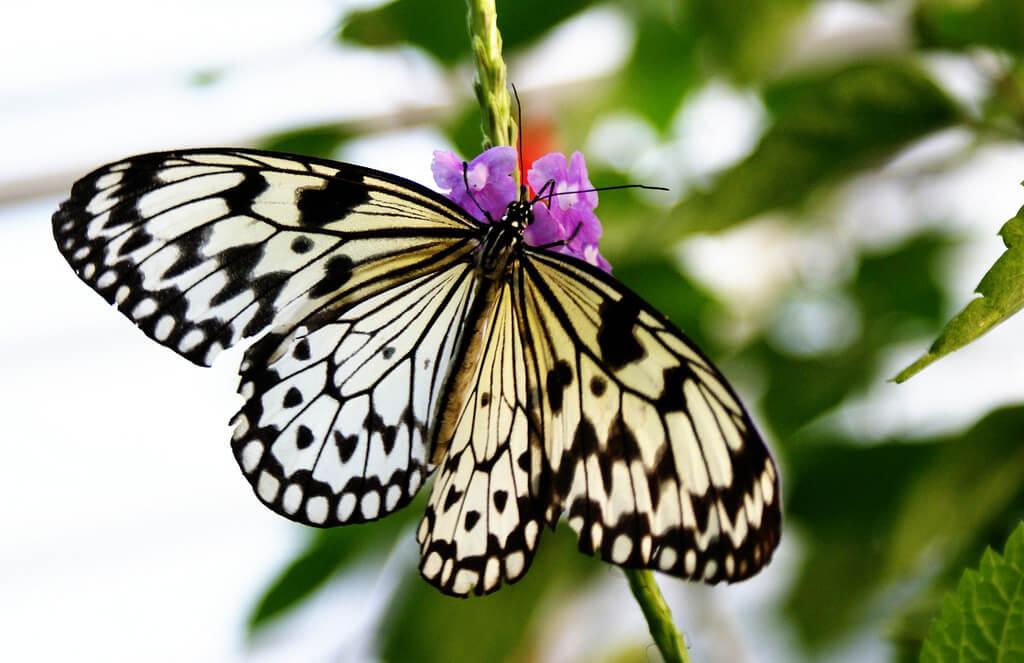
12. Release Your Butterfly Into The Wild
When it is time to release your butterfly, gently carry it or its cage outside. Make sure that your pets aren’t nearby so that you can avoid having it eaten by an eager animal as soon as its released.
Gently lift your butterfly out of the cage. Lift it up toward the sun and wait. Your butterfly will become curious and will fly away. Enjoy watching its path as long as you can see it!
14. Consider Growing A Butterfly Garden To Promote Butterfly Health
Once you have enjoyed raising your very own butterflies, you probably want to encourage the growth and health of all butterflies. You can do this by growing a butterfly garden.
Many butterfly plants are sprayed, weed-whacked, and pulled up because they aren’t traditional landscaping plants.
You can help foster a safe place for butterflies by growing butterfly-friendly plants. Even if you live in the city and have no yard space, you can grow potted plants that are butterfly friendly and hang them outside your balcony or windows.
Many butterfly-friendly plants are also flowering plants. This means that you can have a little more wildflower garden while helping the ecosystem!
15. Share Your Experience With Your Friends To Promote Butterfly Awareness
Be sure to share your experiences with your friends and colleagues. Many people haven’t been able to see or experience a caterpillar form into a pupa, or a butterfly emerging from a chrysalis.
Telling others about your experiences increases awareness around the plight of the butterfly. You can encourage your friends to help protect butterfly-friendly plants and to raise their own butterflies. If each person did a little to help butterflies, it would make a big difference.
Can You Have A Butterfly As A Pet?
Butterflies can be kept as a pet, but not in the traditional way. Butterflies are the happiest outside. If you are raising a butterfly that is native to your area, you should plan to release your butterfly within 3 or 4 days after it emerges from the chrysalis.
If you are raising a species that is not native to your area, you can keep it. Keep in mind, however, that the average lifespan of a butterfly is 2-3 weeks.
That means that your butterfly pet won’t live a very long time. In captivity, you are likely to see your butterfly die even sooner than 2-3 weeks. Make sure that you understand your specific variety of butterflies needs and that you provide the right type of food and water for it.
Butterflies usually drink nectar for their food. You can create nectar by mixing sugar water together.
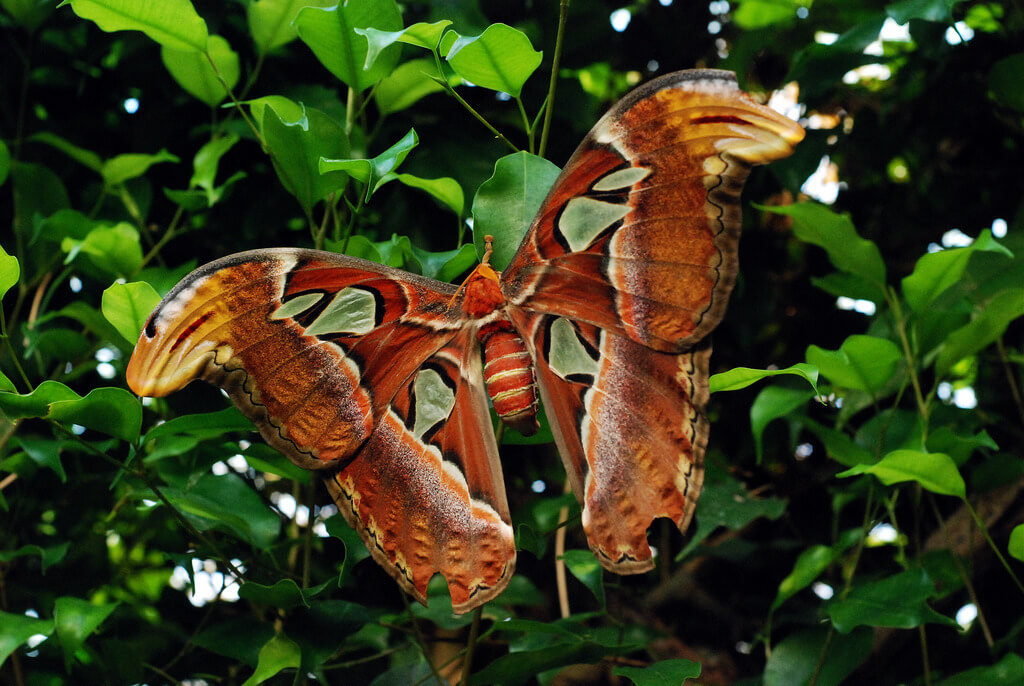
Can You Raise Monarch Butterflies?
People who raise monarch butterflies and then release them into native areas help to preserve a beautiful species. It is not difficult to raise monarch butterflies and can be done, even by novices. A monarch caterpillar only eats milkweed and so it’s important to provide plenty of milkweed for your monarch caterpillar.
Raising monarchs and releasing them into their natural habitats helps them to survive. Monarch butterflies are beautiful large butterflies. They are struggling because they only eat the milkweed plant, which is usually considered a weed by most people. Their food sources have greatly diminished over the last few decades.
In addition, an unusual freeze in Northern Mexico killed off millions of monarch butterflies during their winter migration. This has contributed to the rapid decline of the monarch butterflies.
How Long Can You Keep A Butterfly After It Hatches?
Once a butterfly has emerged from its chrysalis or pupa, you should only keep it three to four days at the longest. But, you should not release a brand-new hatched butterfly that is younger than two or three hours.
A very young butterfly has wet wings and won’t be able to escape a predator. This puts it as a much greater risk.
Ideally, between 3 hours of life as a butterfly and 2 days of life, your butterfly should be released into nature.
Can I Raise Butterflies In My Garden?
Raising butterflies in your garden can be fairly easy. You need to plant and cultivate butterfly and caterpillar friendly plants. These plants provide food, shade, and protection for your butterflies.
You will also need to provide some butterfly-friendly trees. Many trees are also food for caterpillars. They will also provide protection and camouflage from predators.
Your butterflies need some sunny spots in your garden. Many of the plants that butterflies love need at least some full sun each day. This is helpful for your butterflies because they need the warmth of the sun to stay warm. Butterflies are cold-blooded and will chill easily in the shade.
Does Touching A Butterfly’s Wings Kill It?
Butterflies do not die when their wings are touched. But, their wings can be damaged or ripped, which causes additional danger for them. Butterfly wings have dust, or tiny scales, that help them to fly. If a lot of the scales rub off, then it can make it hard for the butterflies to fly. This does put them at risk for predators and create difficulty in them finding food.
But, butterfly scales are meant to come easily off and butterflies lose at least a few scales when they fly.
If you handle butterflies gently, then they can continue to fly and be healthy after you have held them.
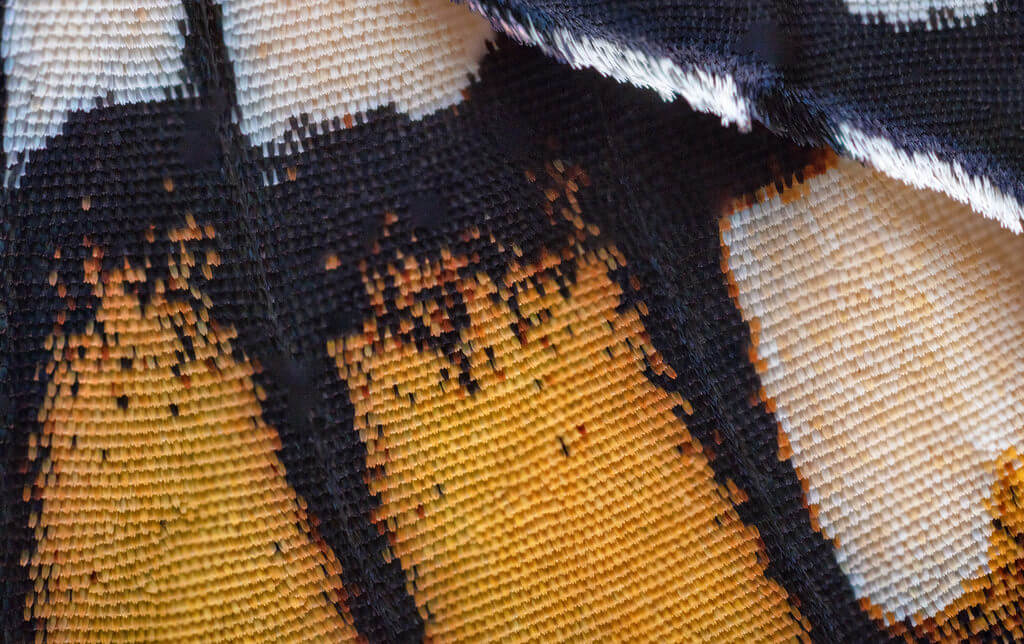
What If My Chrysalis Falls Down?
The most important thing for a butterfly emerging from a chrysalis is to be able to hang upside down. There are two things that you can do to help your butterfly if the chrysalis falls down.
Place the Chrysalis on a paper towel. Put some long sticks nearby. Some species of butterflies can climb up the stick to hang and dry their wings.
Use a semi-cooled dab of hot glue to glue to chrysalis to paper. The glue should be a little soft, but not hot enough to hurt the butterfly. Once the glue completely cools, pin the paper to the top of your cage. This will ensure that the butterfly can hang once it emerges.
Can I Release Butterflies At My Wedding?
Releasing butterflies at weddings, birthdays, or other special events is becoming popular. However, it poses a big danger to the butterflies. Many species of butterflies fly long distances for the winter.
Moving them from their place of origin where they hatched often causes confusion with them. They may not be able to make the right migration south to survive the winter.
Further, they may not be aware of local food sources and are often more susceptible to predators. If you absolutely must release butterflies at your event, please obtain locally grown butterflies to release so that you can help to provide the best odds for them to survive.
[post-carousel id=”562″]





